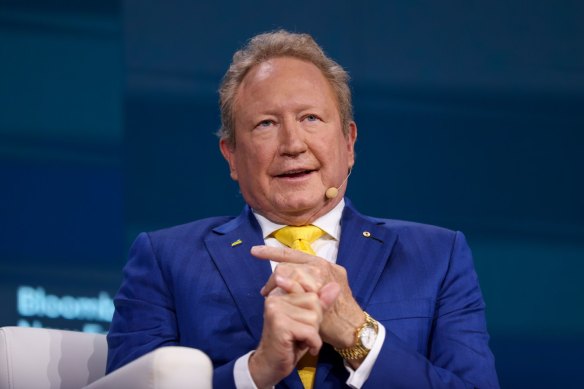Twiggy Forrest’s Wyloo gains control of Mincor in critical mineral race
Save articles for later
Add articles to your saved list and come back to them any time.
Mining magnate Andrew Forrest has seized control of ASX-listed nickel miner Mincor Resources, fortifying his position as a key critical minerals’ producer ahead of an expected surge in demand for the materials needed to help decarbonise the planet.
Wyloo, a company wholly owned by Andrew and Nicola Forrest’s private investment group Tattarang, has increased its interest and voting power in Mincor to about 90.87 per cent, allowing it to compulsorily acquire any remaining shares it doesn’t own and take the company off the Australian bourse.
Andrew Forrest is leading a multibillion-dollar push to diversify iron ore giant Fortescue Metals Group.Credit: Bloomberg
Nickel is a key ingredient in rechargeable batteries.
Wyloo has steadily increased its stake in Mincor since launching an on-market takeover offer at $1.40 cash per share. The company said it gained majority control by close of trade on Tuesday, allowing it to mop up any remaining stock. Mincor shares flatlined on Wednesday giving it a market capitalisation around $760 million.
“Compulsory acquisition will be on the same terms as those offered by Wyloo under the offer, which means that remaining shareholders will receive $1.40 cash per Mincor share,” the company said.
Forrest said Wyloo was a major supplier of critical minerals and would play a crucial role in meeting global demand.
“Wyloo has targeted nickel sulphides as they are the greenest and cheapest option for battery manufacturing: they have the best economics, can be processed into battery grade nickel with the lowest environmental footprint and are fully recyclable,” he said.
“We are going to give the market a choice between clean nickel and dirty nickel.”
Critical minerals – elements such as cobalt, magnesium and lithium – are vulnerable to supply disruptions but deemed essential for defence applications or moving the economy away from its dependence on polluting fossil fuels.
Many rare earths and minerals are produced or mined in China, giving it a stranglehold that is causing alarm among Western governments who are seeking to shore up their own supplies.
Forrest is leading a multibillion-dollar push to diversify iron ore giant Fortescue Metals Group into green hydrogen production and alternative energy, a bumpy investment path that recently led him to clash with tech titan Mike Cannon-Brookes in a bid to wrestle solar company Sun Cable out of voluntary administration.
‘We are going to give the market a choice between clean nickel and dirty nickel.’
Wyloo’s chief executive, Luca Giacovazzi, said Mincor’s acquisition turns Wyloo into a fully integrated nickel business, bringing together high-grade nickel production from Mincor’s Kambalda project in Western Australia with Wyloo’s planned integrated battery material processing facility in Kwinana. Kambalda is one of the world’s most prolific nickel sulphide regions.
“The acquisition also complements our high-grade Eagle’s Nest nickel-copper-platinum metals project in Ontario and our exploration projects in Quebec,” Giacovazzi said.
Two years ago, Wyloo beat BHP in high-stakes bidding war to gain control of Canadian nickel explorer Noront Resources. Noront’s so-called “Ring of Fire” ore bodies include Eagle’s nest, McFaulds (copper and zinc) and the Big Daddy, Black Thor and Blackbird chromite deposits.
“By adding Mincor to our portfolio, we’ve introduced a producing mine alongside our long-life development projects, with all our ore bodies located in the tier-one jurisdictions of Australia and Canada,” Giacovazzi said.
The biggest shareholders left on Mincor’s register at the offer’s end were international fund managers Blackrock, State Street, Vanguard, Norges, Wilson and Tribeca. Together, they held nearly 10 per cent of the stock.
The Business Briefing newsletter delivers major stories, exclusive coverage and expert opinion. Sign up to get it every weekday morning.
Most Viewed in Business
From our partners
Source: Read Full Article


